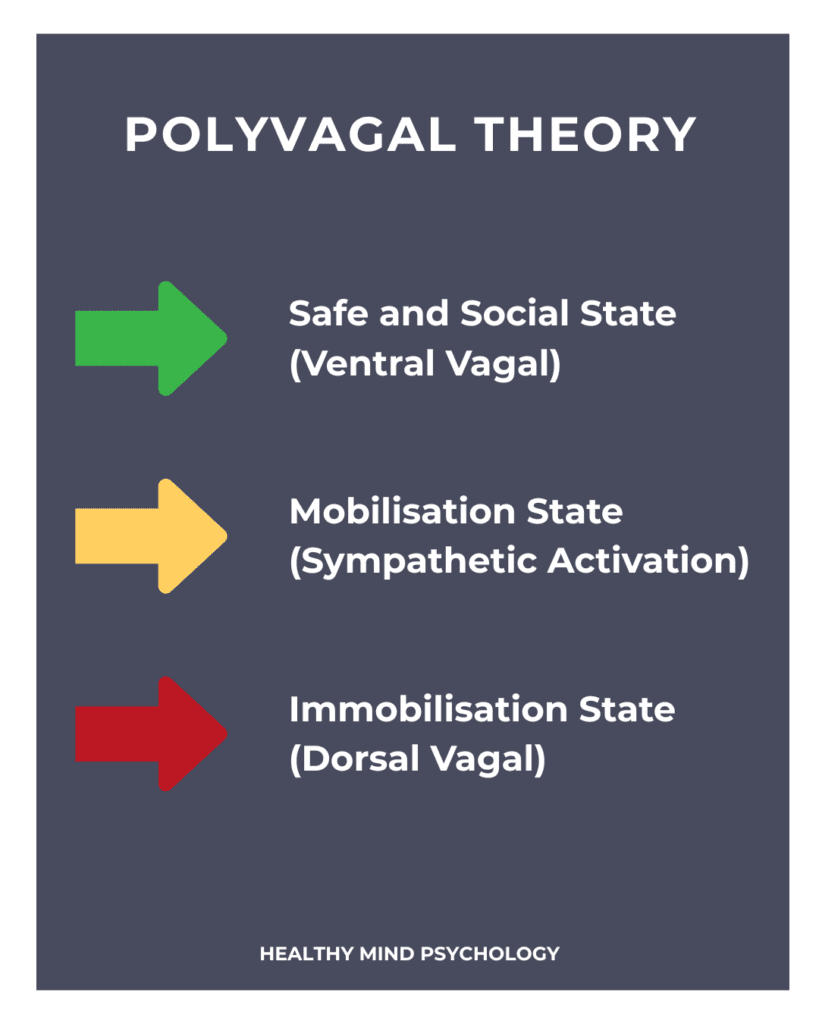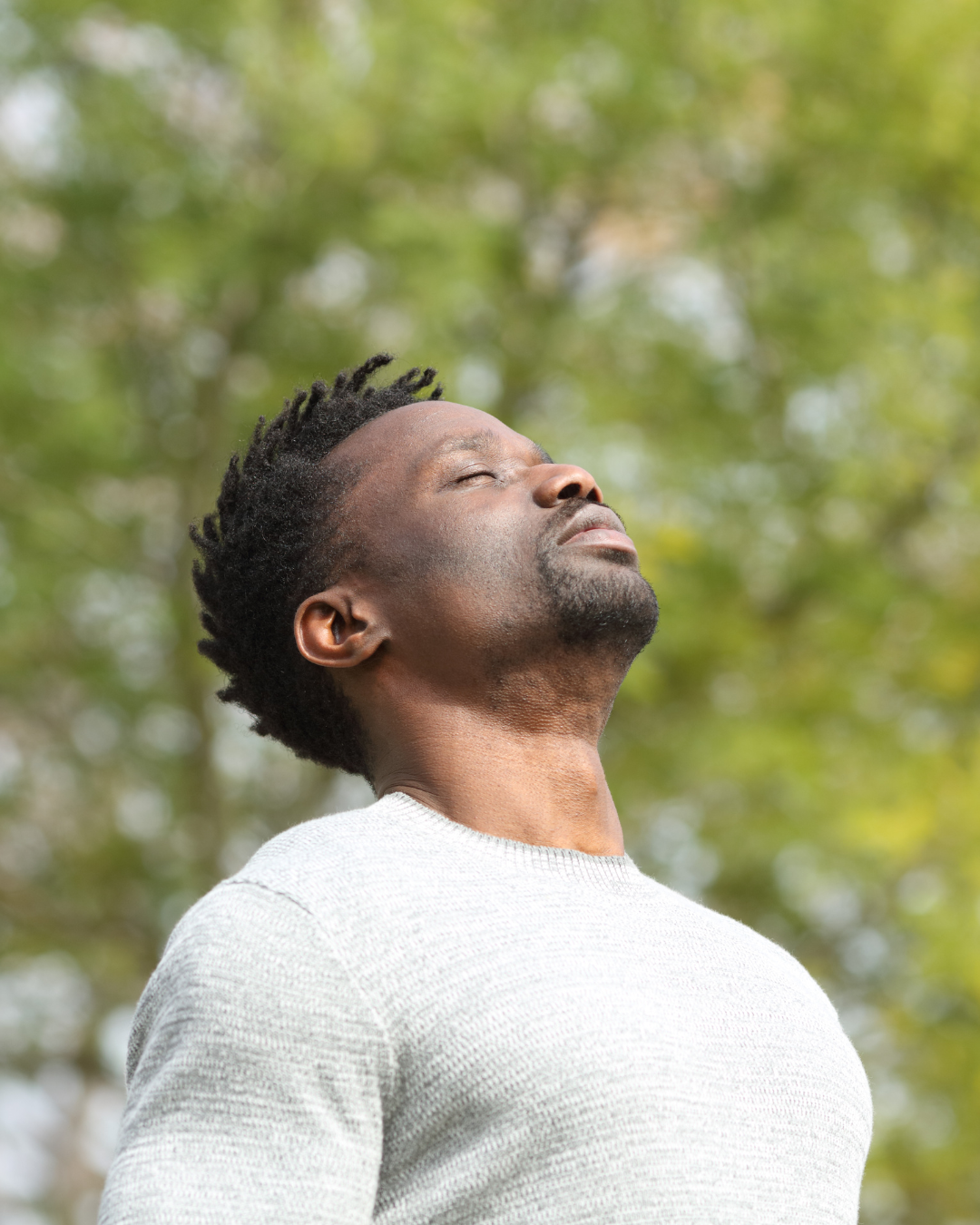Polyvagal Theory: Navigating the Wisdom of Our Nervous System
Our nervous system is far more than a simple on/off switch. Often described as the body’s ‘command centre’, it’s a sophisticated and dynamic system that is continuously responding to the environment and to our needs in real-time, playing a crucial role in our ongoing mental and physical well-being.
The Three States of Nervous System Activation
In 1994, Dr Stephen Porges introduced Polyvagal Theory as an explanation for how the autonomic nervous system (and particularly, the vagus nerve) influences our social behaviour, emotions, and stress responses.
Polyvagal Theory reveals three distinct states of nervous system activation:
- Safe and Social State (Ventral Vagal)
- This state is characterised by feelings of safety and connection
- Heart rate is normal and breathing regulated
- Enables social engagement, creativity, and emotional regulation
- Promotes rest, recovery, digestion and healing.
- Mobilisation State (Sympathetic Activation)
- Fight-or-flight response activated following a perceived threat
- Increased heart rate, blood pressure, hormone flow and muscle tone
- This state can be adaptive or maladaptive
- Immobilisation State (Dorsal Vagal)
- This is state of shutdown in response to an overwhelming of persistent threat
- Triggered by severe stress or trauma
- Slow heart rate and breathing, low muscle tension
- Related to feelings of emotional numbness and disconnection.

When we’re in a safe environment, with no threats (real or perceived) present, we find ourselves in a ventral vagal state. We feel calm and happy, our bodies are able to function healthily, and we’re open to social connection and creative thinking. Imagine sitting in bed drinking a hot cup of tea, or taking an afternoon stroll!
When we experience a threat or stressor, our bodies become mobilised and prepare physiologically to mount a defence against the perceived danger. This fight-or-flight response is helpful, from an evolutionary perspective, as it’s designed to promote survival as we either flee or resist danger. Sometimes, the threat is very real, and it’s easy to understand why our bodies might respond in this way. Our nervous system can also make mistakes, forcing us into this hypervigilant defensive state when we’re feeling stressed or anxious, even in the absence of a tangible physical threat in our environment.
When a danger appears inescapable – which happens when we’re faced with extreme situations, go through trauma, or are exposed to repeated stress – the dorsal vagal response is to shut down. Also an evolutionary survival mechanism (often seen as ‘playing dead’ in animals), our heart rate and breathing slows and we find ourselves feeling detached and numb to the world around us.
The Nuanced Nature of Stress: More Than Just a Negative Experience
Contrary to popular belief, not all stress is harmful. The Yerkes-Dodson Law (1908) illustrates that moderate levels of arousal can actually enhance performance and creativity.
If we’re feeling somewhat safe when we enter the mobilisation state (sympathetic nervous system activation), we can experience:
- Increased focus and concentration
- Enhanced problem-solving abilities
- Heightened creativity and innovation
- Feelings of excitement, passion and energy
Peak levels of arousal in this state can equal optimal performance … up to a point. If this tips into too much stress (or if we feel threatened and unsafe), the positive benefits of high arousal will fall away and we enter fight-or-flight, also putting ourselves at risk of reaching a state of immobilisation experiencing shutdown, burnout and risking our physical and mental health if we spend too long there.
It’s a delicate balance between optimum arousal and productivity and avoiding stress that feels chronic or unsafe – one that’s tricky to maintain, particularly in today’s modern world with increasing challenges and pressures.
From Theory to Practice: Navigating Nervous System Health
Understanding Polyvagal Theory offers more than just intellectual insight – it provides a roadmap for intentional self-care and emotional regulation. By recognising our nervous system’s intricate responses, we can develop targeted strategies to support our mental and physical well-being. The mind-body connection isn’t just a theoretical concept, but a lived experience that we can actively influence through conscious practices.

Practical Ways to Regulate Your Nervous System
1. Returning to the Breath as a Regulatory Tool
The vagus nerve plays a crucial role in our parasympathetic nervous system, and breathing is our most immediate access point to nervous system regulation:
- Practice diaphragmatic breathing: Slow, deep breaths that expand the belly
- Try the 4-7-8 technique: Inhale for 4 seconds, hold for 7, exhale for 8
- Use rhythmic breathing during stressful moments to shift from sympathetic to ventral vagal state
2. Somatic Awareness Practices
Developing body awareness helps us recognise and respond to nervous system states, as well as releasing muscle tension and improving vagal tone:
- Practice body scan meditations (not just at ‘stressful’ moments, but in moments of calm and safety)
- Explore gentle movement practices like yoga or tai chi
- Embrace mindful movement that focuses on internal sensations
- Track your own physical responses to emotional experiences (what do you notice happening in your own body when you’re feeling stressed or anxious?)
3. Sleep Hygiene and Restoration
Prioritise consistent, quality sleep to allow for nervous system repair and neurotransmitter replenishment.
- Maintain a consistent sleep schedule
- Create a calm, dark, and cool sleeping environment
- Develop a relaxing pre-sleep routine
- Limit screen time and blue light exposure before bed
- Practice relaxation techniques like meditation or gentle stretching before sleep
4. Nature Connection
Spending time in natural environments reduces stress hormones and activates parasympathetic functions:
- Spend regular time outdoors, even if just for short periods
- Take regular breaks from screens and notifications to reduce the constant stimulation that keeps the nervous system in alert mode.
- Use natural soundscapes (birdsong, water sounds) for relaxation
- Expose yourself to natural light, especially in the morning
5. Boundary Setting
Limit exposure to stressors and energy drains by establishing clear personal and professional boundaries:
- Learn to say ‘no’ to commitments that overwhelm you
- Communicate your needs clearly and compassionately
- Create physical and emotional space from stress-inducing situations
- Recognise and respect your personal limits
- Practice self-compassion when establishing and maintaining boundaries
6. Social Engagement
Engaging in positive social interactions triggers oxytocin release and co-regulation, counteracting stress responses:
- Cultivate relationships with people that make you feel emotionally safe
- Practice active listening and empathetic communication
- Engage in co-regulated activities (shared calm experiences)
- Use positive social interactions as a reset mechanism for when you’re feeling stressed or overwhelmed

The Ongoing Journey of Nervous System Regulation
It’s important to approach these strategies with self-compassion. Nervous system regulation is not about perfection, but about gradual, consistent care. Each individual’s nervous system is unique, and what works for one person may differ for another. Experiment, be patient with yourself, and consider working with a trained professional who understands Polyvagal Theory if you’re navigating complex emotional terrain.
If you’re struggling with chronic stress, anxiety or burnout, We can help. Our therapists understand traditional and more modern ideas behind psychology and neuropsychology, and can help you to fill in the gaps of how your daily life can affect your mental health and use multiple treatment modalities to help you discover how a healthy mind can support a healthy body. You can read more about our services and how we help here.
References:
Porges, S. W. (1995). Orienting in a defensive world: Mammalian modifications of our evolutionary heritage: A Polyvagal Theory. Psychophysiology, 32(4), 301-318.
Yerkes, R. M., & Dodson, J. D. (1908). The relation of strength of stimulus to rapidity of habit-formation. Journal of Comparative Neurology and Psychology, 18, 459-482.
To find out how we can help you or for further information, please contact us below:

